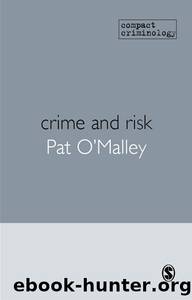Crime and Risk by Pat O'Malley

Author:Pat O'Malley [O'Malley, Pat]
Language: eng
Format: epub
Tags: Social Science, Criminology
ISBN: 9781847873514
Google: 8AY4yfuct9QC
Publisher: SAGE Publications
Published: 2010-05-05T05:09:23+00:00
Risk-taking and the world of classical liberalism
Benthamâs rational choice offender not only weighed up the costs and benefits of any action, but also assessed their relative probabilities. For this reason, Bentham and other classical criminologists put great emphasis on increasing the certainty of capture, over and above the prevailing eighteenth century idea that deterrence would be achieved by fear of severe punishment. The ârationalâ offender would effectively be deterred by a penalty only marginally in excess of the prospective gains, where capture was made highly likely. This contrast with the spectacular but sporadic regimes of punishment associated with the pre-liberal years was not only associated with the rise of the âdisciplineâ of docile bodies, as Foucault argues, but equally with a disciplinary vision of a form of subject who should take on what Bentham (1962 [1789]) called âthe yoke of foresightâ. Everyone was expected look to the future in a calculative fashion. While, of course, this was not entirely new, what was novel was the expectation that all subjects should plan ahead, that this would be an expectation of virtually every facet of life at all times. Subjects would be made personally responsible for the foreseeable consequences â the productive and the harmful risks â of their actions. It was assumed that most people would benefit from this rationally calculative activity, as wealth would accumulate across the society. Yet the idea that most people would become capitalists was very far from the minds of those such as Bentham. Foresight in the lives of most people was expected to be directed more toward making provision against the harmful potentialities of a free market economy.
âPrudenceâ is the name most associated with this regime of risk-avoidance and harm minimization. Its twin components were both disciplinary: a discipline of diligent labour matched with a discipline of thrift and saving. This, it was expected, would create a certain kind of freedom â an âindependenceâ of individuals who would be financially autonomous and thus able to direct their lives without being a burden on others. It was a way of life that required constant self-denial and deferred gratification. For those who failed in this regime, the workhouse provided both a deterrent spectre and a harsh regime of training. For those who refused or rebelled against this regime, or who were constituted by courts in this fashion, the prison provided a similar but harsher alternative. Drunkenness, vagrancy, indigence, gambling, disorderly behaviour and idleness formed a pool of behaviours that consigned a vast number of offenders and their families to one or other of these forbidding institutions. They were offences against prudence, against the demand to look forward and prepare â to govern lifeâs harmful risks âresponsiblyâ.
Naturally, for some subjects, there was an upside. Capitalists, speculators, explorers and military adventurers were risk-taking heroes of nineteenth-century society, but it was taken for granted that these roles were restricted by class, race and gender to a handful of people. For example, women were barred from stock markets, even had they
Download
This site does not store any files on its server. We only index and link to content provided by other sites. Please contact the content providers to delete copyright contents if any and email us, we'll remove relevant links or contents immediately.
The Thirst by Nesbo Jo(6784)
Permanent Record by Edward Snowden(5709)
The Myth of the Strong Leader by Archie Brown(5391)
Spare by Prince Harry The Duke of Sussex(5028)
A Higher Loyalty: Truth, Lies, and Leadership by James Comey(4817)
Secrecy World by Jake Bernstein(4611)
Adulting by Kelly Williams Brown(4458)
The Borden Murders by Sarah Miller(4211)
Machine Learning at Scale with H2O by Gregory Keys | David Whiting(4038)
Killers of the Flower Moon by David Grann(3923)
American Kingpin by Nick Bilton(3731)
Fear by Bob Woodward(3611)
The Secret Barrister by The Secret Barrister(3589)
Future Crimes by Marc Goodman(3488)
The Last Girl by Nadia Murad(3414)
The House on Mango Street by Sandra Cisneros(3371)
Liar's Poker by Michael Lewis(3343)
The Social Psychology of Inequality by Unknown(2917)
Graduate Admissions Essays, Fourth Edition: Write Your Way into the Graduate School of Your Choice (Graduate Admissions Essays: Write Your Way Into the) by Asher Donald(2849)
